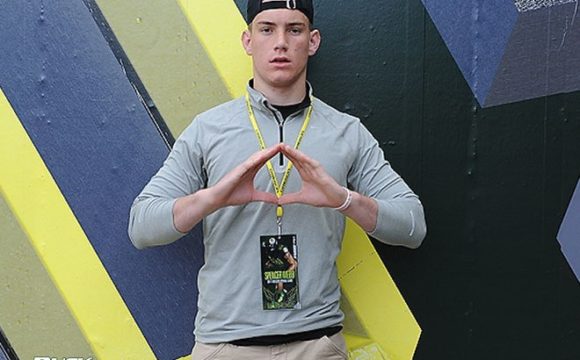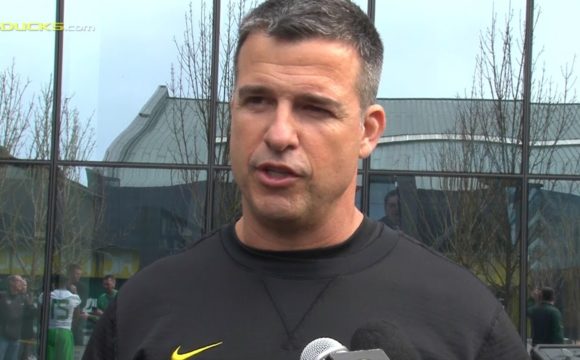THE GOOD
The weekend which seems to never end for Oregon recruiting was one of the most impressive weekends I have seen in all of the years that I followed – and then covered – college football recruiting. Teams recruit. All coaches do it, and all coaches aim for the best recruiting classes possible. It is no secret that the Oregon football team was languishing in the early national rankings for the recruiting class of 2018; the Ducks were at number seventy-four in the Rivals rankings prior
to the Spring Game. They had a single commit.
And then the commits started rolling in; six in a twenty-four hour period. The Ducks need a lot of help, especially on defense, so it is no surprise that some of the recruits were on that side of the ball. I would say that it would be considered a coup to snag Steve Stephens, but it really is not that much of a surprise; Pac-12 schools regularly reach into Fresno for recruits. Certainly it was no surprise when the Ducks landed Dawson Jaramillo.
In fact, none of the names were surprises to those that follow Oregon recruiting. But for those outside of the Oregon fan base, one name really changed the manner in which Willie Taggart and the new Oregon staff was viewed: Isaiah Bolden.
Formerly committed to Florida State and hailing from the Sunshine State, most people outside of Eugene thought it a joke that he could be flipped. “A free trip” would have been the criticism of some fans – except it was an unofficial visit, so it was far from free.
Bolden and his father visited Eugene and saw everything they needed to see. I talked to Bolden several months ago and he really just wanted to make sure that the school felt right. He has a very long and well-established relationship with Ray Woodie from his days at USF with Taggart. Woodie, who led the recruitment, is one of the flat out best recruiters in the nation and he did a tremendous job keeping the door open with Bolden.
Does this mean the Ducks have established a pipeline? That is difficult to say, and a direction in which I do not want to go yet. The new staff certainly has made some noise in the state with the closing of the 2017 class and the open of the 2018 class, but the Bolden flip is bigger than anything he has done to date. Most importantly, though, the ‘juice’ being sold will require results.
One thing to be learned from basketball and the AAU circuit, kids do not want to travel somewhere away from friends and family to lose or to be embarrassed on national television. The ‘juice’ is on the loose right now, but there need to be results when fall arrives.
THE BAD
While there are recruiting successes, there must also be some failures; either of the staff to woo a highly sought after target, or of the prospect making a choice he might later regret. It happens every year and there is really not much that can be changed.
Except that there is. I think that decision are made for far too many of the wrong reasons. At the end of the day, college football is still supposed to be about exchanging a gift (athletics) for an education. There are long hours and a lot of hard work involved in becoming a college football player and those hours do not get any easier when kids arrive on campus.
The NCAA has been doing their best to get in front of the problem, but they simply have their hands tied. There is too much money involved at the level of schools and conferences. What I am talking about, of course, is the difficulty of a prospect getting out of a National Letter of Intent.
I get the whole ‘you made a commitment, signed a contract, and now you have to live up to it’ argument. I really do. But there are too many kids choosing schools for the wrong reasons. If we are going to concede that kids choose schools because of the coach, then the kid should be allowed some form of limited ‘free-agency’ should the coach get fired after a NLI is signed.
It does not have to be completely voided, but he should have options. Maybe this will stop schools from lying about a coach about to be fired; maybe it will allow kids to make better, more informed choices. In principle, they should be choosing the best school for their long term goals. But this is the real world and it just does not work that way.
THE UGLY
Recruiting is an ugly business. Coaches get evaluated by how well they do their job. Head coaches get judged by wins and losses. So too do assistant coaches get judged by their results. A big part of that is how well they recruit.
The thing is, this fight is not just against coaches from other staffs, but sometimes within a staff. Who gets credit for landing a recruit matters. Recruiter of the year awards, bonuses, new contracts, extensions, promotions. All of these depend on how well assistant coaches perform on the recruiting trail. And they are a big reason coaches need to be recognized for who the recruit.
There is another ugly side of the recruiting process that sometimes gets left out of the headlines. We talk about stars, stats, offers and interest. Somehow, though, we forget that each school has a finite number of scholarships available at every position.
We have all seen the headlines about an offer being pulled at the last second leaving a kid out in the dark. It is devilishly unfair. But there is an issue at the other end of the recruiting cycle that could become just as devastating.
Pressure.
Coaches want to fill their recruiting classes as early as possible so they can start working on the next class. Always be recruiting. What this means is that coaches are continuously asking kids to make their decisions earlier and earlier. They are pressured for a quick decision. Sometimes, those decisions cannot simply be made because you like the coach and the school. Comparative analysis can be important for being sure a decision is right.
We see it everyday; a kid ‘decommits’ from a school saying that he made the decision too soon. He might actually miss out on the school he might have liked the most because his scholarship is no longer available. This is one reason I whole-heartedly support the decisoion to add an early visit period, effective next April.
Let these young men get around the country and check out their five schools so that they can make a truly informed decision. Their commitments will be stronger and their effort better in the long run.


